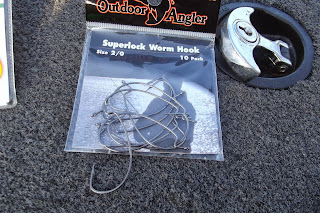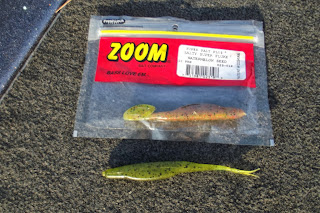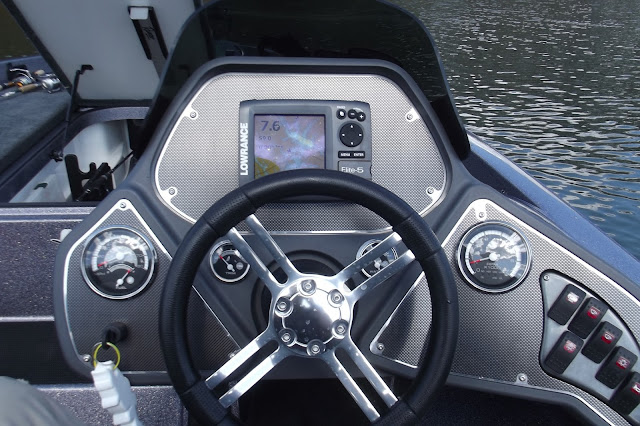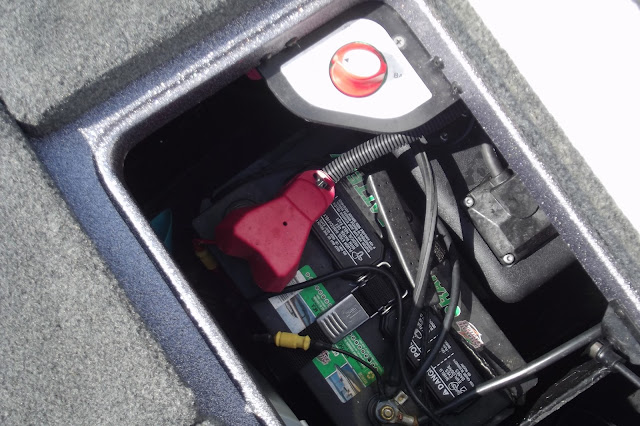The
Ranger 117Z at about half throttle - around 3500 RPM's - moves at about 30 MPH. This is an extremely comfortable speed for this boat, especially if the water is a bit rough Today it was very calm; the picture below is the boat at about 40 MPH - it is stable as a rock at this speed. Thanks to Dennis Porter for taking care of the driving - he's one of the best.
But today we are talking about the interior of the boat again, touching on the things that we did not discuss last time. Let's start with the console!
There are four gauges; the Speedometer also holds the fuel gauge, which shows empty long before you actually get there, a feature I greatly admire. The tank is 22 gallons and I have recorded an easy range (using the distance tracking feature on the GPS unit) of at LEAST 200 miles. I am going to find that number out exactly in later experiments, but this will depend greatly on driving style and water conditions.
The inside left gauge is the trim/tilt - 1/2 to 3/4 up at speed usually results in the best ride, but the slower you go the lower you will want your tilt to be to keep the boat from porpoising or bouncing. The right hand inside gauge indicates water pressure, and the far right hand gauge is the tachometer. All of the gauges except the speedometer are very stable and accurate; the speedometer, like most boat speedometers, does not do well at slow speeds and occasionally registers wildly inaccurate speed readings - that is simply one of the things that mechanical speedometers do when you stick them in a watercraft and to me it is not that big a deal. The water pressure and tachometer are the truly important gauges.
The buttons to the right are easily laid out, and the entire dashboard is accessible to replace anything that may go bad, or to add new hardware mounts if needed. The buttons for the lights and the motor trim are duplicated at the front of the boat.
There are two bilge pumps, one of which is always on automatic, the horn, the interior lights, the running and anchor lights. The button for the trim control in the drivers station is, of course, on the throttle control.
Note the livewell switch to the right of the throttle - there are three modes, empty, recycle and fill. The recycle mode allows you to do this when the boat is out of the water:
Minnows (as long as it is not to hot) will last up to 4 days or longer in the livewell. All minnows not used are set free, and none were harmed in the making of this blog, other than being stuck with sharp hooks and fed to predatory monsters.
Since I am not a good fisherman, most of my minnows tend to be set free:)
Since I got this boat I have not had a batch of minnows die from lack of oxygen or poor water quality, and it has cut down on my minnow purchases tremendously - that, when combined with the lunkers I am reeling in as pictured below:
make this one of the smartest financial purchases of my life - I know that is what my friends say, but they do not understand boats. I love all boats, don't get me wrong; rowboats, rubber boats and sail boats. But there is something extremely nice about a boat that will move at emergency speeds and which will start every single time I turn the key. I have had plenty of boats that would do neither.
And trust me, when you are 7 miles from the landing on a darkening and cloudy night, the last thing you want is a motor that does not start. For the foreseeable future - that is something I simply don't have to worry about. If I get stranded with this boat, it will be because of my own obstinance and stupidity, which, lets face it, sometimes those things surface in me like a gar on Mountain Island Lake.
Anyway - I have mentioned before that this boat is specked at the Ranger website with a 24v trolling motor and a Lowrance Mark 5X Pro in the driver's cockpit and the front of the boat. At Denver Marine, they had the boat outfitted a bit differently, choosing a 12V trolling motor. There are not a lot of fast rivers around, and a 12v trolling motor has not let me down in this boat yet - or a fast river current. The speed setting I choose is usually on 3 - 4 but 5 has always been more than enough to pull my boat where I needed it to go.
So, in the bow the Lowrance Mark 5x Pro is shown below;
you will notice a small patch of moisture or two on the inside of the screen. Unlike the speedometer, this I do care about. It has been a heavy rain season in NC in 2013, and while I keep the boat under a roof, it has been transported in heavy rain (as well as out on the lake in heavy rain - I like the bad weather, what can I say!).
But, depth finders of this quality should be waterproof and immune to such things. It went away after a few days, I will let you know how this goes with Lowrance. I have made no bones about the fact that I love my boat and that I am biased towards it but this blog is about a long term, real world and above all honest review of the boat and all equipment that is installed now or will be installed in the future.
And with that in mind, Lowrance gets the first demerit - this depth finder should have been completely immune to such problems. But things do happen - a percentage of products will have defects. It is in the way that the companies handle those defects - that is what is important. And, within a day or so, the interior moisture had disappeared. I will let you know how Lowrance handles this.
The other depth finder was a pleasant surprise, and a conscious choice (I am sure) of the way Danny down at
Denver Marine orders these boats. The Elite 5 is way more handy for me than a 24v trolling motor. There is no way to say how important a GPS unit can be, especially on a dark and cloudy night,. I know Lake Norman, and I know big waters, and it is easy to get lost. The GPS unit in the Lowrance Elite-5 takes care of that. And, this unit saw just as much water with no fog inside the screen.
The unit is also very accurate, but as it says you
do not want to rely on this unit for precision positioning of your vessel! That being said, unless you want to spend extra money on an external antenna turn the unit on during the pre-launch sequence a few minutes before the engine cranks. I reckon it is the interference thrown off by the Evinrude's electrical system, but it does acquire the sat signal much quicker if you turn it on a few minutes before the motor is cranked.
The Elite 5 has several different screens and takes aftermarket memory chips - I got the Avionics chip for the South East, and it gives amazing detail, as shown below - this is absolutely better than a 24v trolling motor.
Note the docks - these are actual dock positions! The depth lines are in 1 foot increments and make finding underwater features a snap, especially when the screen is set in the split mode (the pic below was made before I installed the Navionics chip). Below you will also see the compass heading screen - there are many other options.
And the sonar, while not down or side imaging in quite accurate.
I have caught fish already by letting my worm or jig drop straight down when I see signals like this coming from the unit, though the larger green blob on the bottom is more indicative of a branch or other natural feature, and not a fish. Note the temperature lines indicating how deep the thermocline is
Aft Storage
Behind the seating area, there are two main side compartments like the one pictured here:
These are very nice areas for the aft of the boat, which is the area more likely to see whater shipping over the sides, although this is a very dry boat - I love rough water, and when combined with wind and waves, water will come over the side and into this area of the boat. Having these compartments bare is a feature I would not change. I have put water absorption units in all my compartments this year, though - despite being kept under a carport, it has still been extremely humid. You may also want to open the cooler (in front of the drivers seat) and whatever compartment you keep your lines and anchor in. I use one for anchors, extra line and other 'dirty' stuff that will get wet or muddy as a regular course of action. The other, I keep all this in!
Plus a canvas bag pictured earlier and a few other items!
That leaves more than enough room. Note the goggles - these are very useful when traveling at speed, although some sunglasses do a tremendous job. If you don't have a good pair of wind resistant sunglasses, goggles are a godsend. The cheap one's look much dorkier than the wind screens at
Bass Pro Shop, but they are also only $1.79.
The cleats on this boat are very neat looking:
I like the way they retract, but I have to admit I like a larger cleat on my boat. I keep lines tied to them all the time, so the retraction is of minor use to me. If I were on a larger vessel, with longer lines this would be the way to store them:
And this is the way that I actually store them:
It's easy, it does not flop out of the boat and the lies are there for instant use. One thing I will say - nylon line like this one makes really horrible dock lines; they are to slippery, and unless you are really careful a few cleat turns can easily pull loose from the dock during rough water conditions - a fact I discovered when I came back from getting the trailer in the water to discover the boat 10' away from the dock.
The back seat is quite comfortable, and has me wishing for a remote controlled trolling motor, but it is not comfortable enough for me to spring for the extra expense - after all, I did that with the boat already!
The battery and mechanical compartment is very well laid out:
Here are a few closeups.
The battery on the port side is for the trolling motor, on the starboard side for the cranking and other electronics. The cranking battery is charged by the
Evinrude, and the
Pro Charging Station came with the boat, and is a 2 station charger that will accept any standard power cord.
The red switch (top center of the picture below) is a master switch for the batteries; it includes an all off master off switch, and allows you to switch either the trolling battery to crank function, or to combine the two batteries for cranking power. It IS possible to run your juice down to the point where this is necessary, and is a very nice feature.
The oil fill spout:
is very handy, but you will need to keep a funnel to fill it, unless you are a lot better at pouring viscous liquids than I am. A full oil tank lasts for 6 - 7 fuel refills, although I am working off of memory here. When the oil reservoir reaches 1/3 capacity an alarm will sound, and if it runs out the motor will give you several hours of use at around 1500 RPM max - enough to get you back to the dock, or at least to shore. Keep a spare half gallon of oil in the motor compartment with a funnel just in case.
The other lines are just as neat, and I have never had to use the squeeze bulb on the line since Bjorn at
Denver Marine set the motor up for me.
So, that is the
Ranger 117Z - a first look at a great boat. It is fast, fuel efficient and as much as I would want it to does NOT come in dull camo colors or with rod holders - but those are just minor things. I like older boats, and I will be glad when this is one; what I do not like are boats that break down (which is what made me buy this boat).
This review will continue as long as I own the boat (I hope), and I shall always give a stark and no nonsense view of the boat, the Evinrude and all electronics as well.
Until next time, catch more fish than I have, and smooth waters!


































































